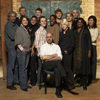iMania
Apple's iPhone captured front pages as journalists drooled over the 'holy grail of gadgets'; but there's more to the world's trendiest new toy than the coverage would have you believe.
When Stan Sutter came home on January 9, his 12-year-old daughter was waiting for him. Sutter had been working all day at Marketing magazine, where he was thenthe associate publisher and editorial director, and his daughter filled him in on the day’s big news. She had read online that Apple Inc., maker of her beloved iPod, was going to combine a cellphone, iPod and mini-computer into one product. The new iPhone would feature Apple’s sleek style and cost $499 US for a four-gigabyte model. “I want one,” she said.
She wasn’t the only one. The next day’s papers heralded the news like Apple had designed the last gadget any human would ever need. The Globe and Mail’s front page ran—under the headline “Is this the Holy Grail of gadgets?” —a PR photo of the phone as its main art. The Calgary Herald ran a photo of a smug Jobs on its cover, the headline quoting him saying “Your life in your pocket.” Within days, Sutter says he had spoken with a Canadian executive ready to fork over roaming fees to buy the first iPhones in June, when Apple planned to release them in the US. “Twelve-year-old kids and 45-year-old ad execs are salivating for these things. And journalists are in that sweet spot too,” says Sutter.
The iPhone may be the epitome of cool, but it could also be Apple’s biggest gamble to date. Not that you’d have known it by reading those January 10 front-page stories, when Canadian journalists gave Apple’s CEO Steve Jobs exactly what he wanted: unflinching and admiring coverage of his shiny new gadget’s 3.5-inch touch screens and visual voicemail. Granted, the cultural and technological force that Apple has become in the past five years made the iPhone the top business announcement of the day. But those first-day stories said little to nothing about the problems attached to the launch. Articles about a federal investigation into backdated stocks, overpricing, and lawsuits contesting the iPhone name slowly appeared.
But those stories were in the business section, where they belonged, and Apple’s free-ad campaign, essentially donated by journalists, had already paid off in a massive front-page assault on the public consciousness.
• • •
The Macworld convention is Apple’s annual State of the Union convention and is renowned for Steve Jobs’skeynote addresses. In 1998, he introduced the iMac, in 2001 the iPod, and this year he gave the world the iPhone. The CEO, dressed in his trademark black turtleneck and blue jeans, spent an hour and a half describing the phone’s features, playing a clip from Pirates of the Caribbean 2, rocking out to the Beatles, and jokingly ordering 4,000 lattes from Starbucks. Part way into Jobs’ perfectly executed sales pitch, he checked Apple’s stock using the phone – up more than $2.50 in one hour. By the end of the day, the company’s value had risen 8.3 per cent. In contrast, Research In Motion, the creators of the coveted Blackberry handheld phone and email device, watched its stock fall 7.9 per cent. It looked as though the revolution was being streamed across the Internet.
As Jobs pointed out in his speech, Apple planned to take one per cent of global market share from its competitors in one year, by selling 10 million units. It is an ambitious but achievable goal; the company sold more than 20 million iPods during the last holiday season alone. Competitors claim not to be worried. Ramon Llamas, a research analyst for the technology research centre IDC, says one RIM employee told him “its like comparing apples to blackberries.” Right now, he adds, the mobile phone industry is waiting to see if the iPhone can impact the market as much as Jobs promises it will – a lofty goal, considering the gadget has yet to receive approval from the US Federal Communications Commission. Until then, Llamas says iPhone is competing in one corner of the cellular sandbox.
A study by the Forrester technology and market research company echoes Llamas’s analysis, saying the cellphone market is such a leviathan that, though Apple’s competitors might need to play catch-up, the industry itself will not change. The study points out that it is the nature of the industry for one company or a manufacturer-retailer partnership– in this case Apple and Cingular, which will be the exclusive carrier of the iPhone – to produce a must-have item, a cyclical process that is characterized by the industry’s hype and aggressive marketing. The iPhone’s superiority will eventually be diluted by imitations and innovations. So Llamas says the real effect of Apple’s entry into the market will force other manufacturers to “push the innovation envelope.” In fact, LG has already revealed its KE850 phone model that has a similar touch screen (three inches to the iPod’s 3.5), leading the Engadget technology blog to ask if they were separated at birth. Apple’s iPhone could do for cellphones what the iPod did for Mp3 players. But Llamas believes the iPhone, like the iPod at first, will need to evolve before it makes a demonstratable impact on the massive cellphone market.
• • •
Roy MacGregor’s column started with, quite literally, a sigh. On January 11, the national affairs columnist for the Globe lamented above-the-fold, top-of- newscast coverage. US invasions, SARS and economic collapse had been all vying for editors’ attention, he pointed out, but none of this could topple iMania. “Cellphone worship, it is now safe to say, has reached its own form of extremism,” MacGregor wrote.
In fact, the only major Canadian daily not to put the iPhone on its cover was the Edmonton Journal. Across the country, iPhone stories quoted few sources—most just repeated Jobs’s keynote speech, which was available for free online. It’s the salesman in Jobs that makes him fun to watch and easy to regurgitate, says Canadian technology blogger Mark Evans. “He’ll go from curmudgeon-like CEO to super sales guy … And, I think the media needs to keep in mind, that is his major skill.” Jobs grants limited access to the media; instead, he announces big projects through Macworld and then handpicks follow-up interviews. In a CNBC interview the day of the announcement, Jobs looked agitated and annoyed. On stage at Macworld, however, he was in complete control.
The intrigue surrounding Jobs is compounded by Apple’s secrecy. In an industry built on hype and well-planned leaks, it is strange for a company to hold tech secrets so close. Still, unsubstantiated iPhone rumours circulated for at least two years – none of which came from Apple. On Dec. 7, 2006, the Globe’sMathew Ingram reviewed the prevalent iPhone “leaks.” Some of them were true (the large video screen and the price range), but most were wrong (touch wheel, slide out keypad). Still, the rumour mill on technology blogs has fuelled Apple’s success, says Ingram.
He can’t think of any other company so able to co-opt journalism for its marketing campaign. On the same day as Macworld, the Consumer Electronics Show was happening in Las Vegas, but was given much less attention. Microsoft, Apple’s biggest competitor, can’t buy equivalent PR for $500 million, Ingram says. Steve Jobs, he says, is like Angelina Jolie to the media while Microsoft CEO Steve Ballmer and co-founder and chairman Bill Gates are Danny Devito.
• • •
Like a bad hangover, the Macworld aftermath stung for a few days as other Apple stories appeared. At the top of the list was that Cisco had copyrighted the iPhone name in 2000, and stories flew about an impending legal battle. Commentators questioned whether sticking with one service provider, Cingular, would hurt the gadget. In Canada, attention turned to Rogers, who will likely carry the iPhone here. And then there was the price. Troy Wolverton wrote on January 13 in the Herald – which had featured the iPhone front and center on January 10 – that $500 is too expensive for young adults and that Apple’s previous big-name products, the original iPod and iPod nano, were “plagued” by quality complaints. Wolverton questioned whether the iPhone is indeed a revolution, adding that “revolutions tend to be messy.”
Ingram says enamoured journalists skipped these angles for a few days until they came out of a collective trance. “I think that’s got to be a part of Apple’s strategy: Just keep talking about your cool products and maybe people will forget about that there’s this investigation into your options backdating. Let’s face it options backdating is boring. It’s not sexy at all. It’s the opposite of sexy.”
Illegal backdating could have more influence on the Apple’s future than the iPhone. Jobs has been accused of benefiting from stock options attached to his infamous $1 a year salary. Essentially, the company is being accused of giving Jobs stock options from before his contract was signed (ie. the 2000 stock price in a 2002 contract), which would increase their value automatically. It is a common corporate ploy to inflate executive salaries. Though he was cleared by an internal review, a federal investigation is about to begin. The media, says Sutter, has started to speak more about this and question if Apple could succeed without Jobs. And as momentum builds to the iPhone’s release in June, Sutter predicts the media will pursue more critical coverage. “If my car broke to the degree, frequency and cost proportionate to what my iPod’s done,” he says, “I would never use that manufacturer again.”
Evans, though, isn’t so sure iMania will die. “Sometimes the media can be fairly well-behaved,” he says. “But when it comes to Apple, they have a tendency of getting far too excited for their own good.”
by John Mather
John Mather was the Managing Editor for the Summer 2007 issue of the Ryerson Review of Journalism.













































